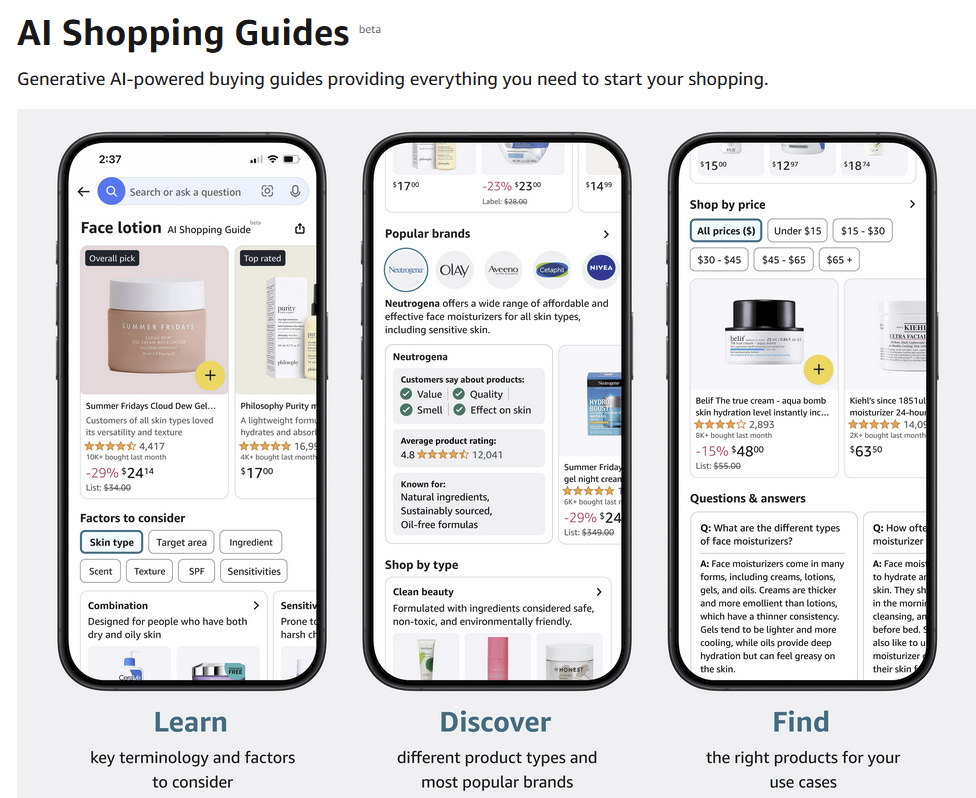Global Digital Marketing & Retail by Alex 61
Inspiration from across the world for retail enthusiasts, e-commerce professionals, marketing lovers and technology fans. Welcome back! I summarized some great links again, I stumbled upon this week.
I have visited the event “shopping today” last week. I think I now have been to this event for 12 or 13 years, and I have seen it grow year on year. This year was a great edition, one of the best I have been to, I think. So many speakers, inspiration and a great location. Thanks for organising “Thuiswinkel.org”!
In this newsletter pictures I made during this day and some short summary’s that you might be able to use!
PS: I know in the substack app, when I use a gallery, you cannot zoom in at the pictures, at least on my Android it does not work. It works on desktop and a mobile browser. A gallery is the only way to put a lot of pictures in a substack newsletter and not exceed the optimum length of a newsletter.
Artwork behind shoppingbadge: https://iriewata.com/👍
🇳🇱 Heineken and Deloitte on AI in the customer journey
Lets’s start with a presentation from Heineken and Deloitte on AI. I summarize in bullets and share the pictures in a gallery, need to keep the bullets short as the length of an e-mail is limited.



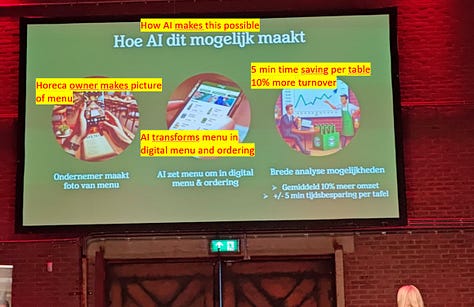




The amount of Horeca Visitors is declining. They expect this will decline more next year.
75% of the beer-drinking people, checks the horeca location first online before they visit physically.
The guest journey before people visit horeca: Heineken does a lot of research to this. In this short presenation they highlight social media and the digital menucard. They emphasis that this journey before the physical visit gets more and more important.
They explaine dutch restaurant chain “Loetje” never had to use social media because they were always fully booked but now reservations are declining and they are forced to start online presence and Heineken helps them.
They help them with their social media presence. Horeca entrepeneurs do not have time or the knowledge to do this succesfully.Heineken helps them with an AI powered tool, to promote their online presence. They offer AI powered tools they can use at their own social accounts.
They als have an AI ‘onboarding’ (bot) for restaurant owners to help them explain how they can use Heinekens’tools. They actively help with hyperlocal targeting and they also use AI for that. They emphasize that these tools help saving time and money for horeca entrepeneurs.
69% of the horeca entrepeneurs still has a labor shortage.
QR code ordering does not have everyones preference, but still entrepeneurs benefit from it. The entrepeneur makes a picture of his menu and the AI powered Heineken tool turns ut into a digital menu and makes a qr code ordering functionality.
How can you go faster in your org. with AI? How to get more out of it? Check out the slides.
Presentation by: Pepijn van der Laan & Pien Frommink
🇳🇱 Performance marketing and strategy
Now a couple of slides on performance marketing and digital strategy, I translated everything important in nice yellow and red!



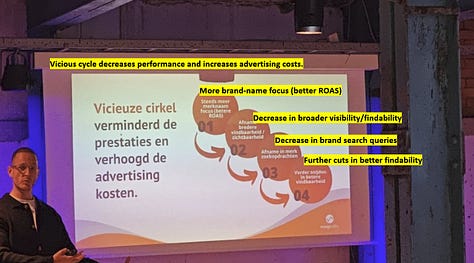

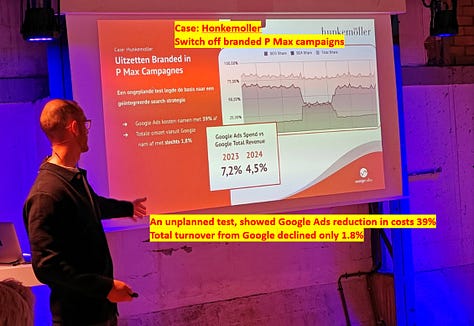


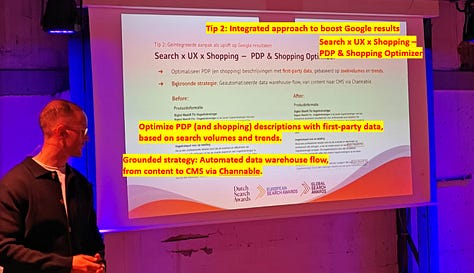
The 6 driver growth model is based on the idea that a business’s growth can be driven by six core activities (Demand Generation, Acquisition, Conversion, Transaction Value, Retention, and Virality). These activities reflect different stages of the customer lifecycle—from generating awareness to retaining customers and turning them into advocates. The six enablers are essential tools or capabilities that support and enhance the performance of each of the growth drivers. Without these enablers, businesses might focus on individual drivers but fail to maximize their potential. For example, a business might generate demand but miss out on opportunities to convert leads or retain customers due to a lack of technology or insights.
In the second slide, the six growth drivers are placed on a maturity scale. The scale shows that businesses can be at different stages for each driver, ranging from Behind the Curve to Market Leader. The goal is not always to reach the "Market Leader" stage in every driver, but rather to achieve an appropriate level of maturity based on the business’s specific needs. They gave an example of a pancake restaurant that does not need to be a market leader in transaction value, but might benefit more from foot traffic or retention.
The roadmap in slide 3 provides a clear, structured plan for advancing in the six enablers.
I have added a slide with a “vicious circle”, from a presentation from “orange valley” it’s about Pmax or similar campaign types, where there is a vicious circle that negatively impacts the performance and increases the costs.
The campaign starts focusing heavily on branded search terms to improve ROAS. This is typical when a campaign shifts towards audiences that are already familiar with the brand.
As a consequence of focusing more on branded terms, the campaign becomes less visible in broader, non-branded search terms, which reduces overall discoverability.
Over time, because there is less exposure to new audiences, fewer people search for the brand, leading to a reduction in the total number of brand-related search queries.
The last bullet, "Further cuts in better findability," refers to the ongoing reduction of resources or budget directed toward improving the brand's visibility. This deepens the issue of lower visibility, making it harder for potential customers to discover the brand, which, in turn, leads to even worse performance and higher advertising costs over time.
This vicious cycle describes how cutting back on broader brand visibility leads to fewer brand search queries and a continued decline in performance, forcing brands to rely more on expensive, performance-driven marketing like ROAS, which increases advertising costs in the long run.
A slide that highlights the challenges advertisers face with the loss of first-party data, leading to a lack of transparency in both reporting and targeting. As digital advertising shifts away from relying on cookies and third-party data, platforms like Meta Ads Advantage+ and Google Ads Performance Max take different approaches to address this gap.
On the Meta Ads Advantage+ side, advertisers retain more control over placement safety, creative assets, and can utilize exclusion-based targeting. However, it lacks key metrics for the upper funnel, limiting insight into brand awareness campaigns.
In contrast, Google Ads Performance Max relies heavily on signal-based targeting, with less granular control over bidding and campaign customization. Automatically generated creative assets and a limited amount of actionable secondary data also pose challenges for advertisers seeking deeper insights and customization.
There are more slides that I think speak for itself, but they are useful to be at many company’s roadmaps, thats’s why I share them, check it all out in the gallery above.
The 6 driver growht model was presented by the level up group
The Pmax slides were presented by orange vally.
🇺🇸 Amazon’s is training it’s shopping concierge and more on future features!
If you like features -as I do- and see the direction things are heading, then this article on Amazon is worth reading. Amazon is focusing on an super expert “shopping concierge LLM”. And also they see -if you read between the lines- a future where AI agents do the shopping for customers and maybe negotiate as well. I wrote earlier on that. Also in the article, the recently released Amazon AI shopping guides are mentioned, you can test them yourself already now.
Executives at the company say its engineers are also exploring more ambitious AI services, including autonomous AI shopping agents that recommend goods to a customer or even add items to their cart.
Chilimbi says the first step toward AI agents will likely be chatbots that proactively recommend products based on what they know of your habits and interests, as well as a grasp of broader trends. He acknowledges that making this feel nonintrusive will be crucial. “If it’s no good and annoying, then you’ll tune it out,” he says. “But if it comes up with surprising things that are interesting, you’ll use it more.”
Future AI agents might, for instance, navigate various websites to sort out a parking ticket, or they might operate a PC to file a tax return.
Amazon’s agents are, of course, likely to be more focused on helping customers find and buy whatever they need or want. A Rufus agent might notice when the next book in a series someone is reading becomes available and then automatically recommend it, add it to your cart, or even buy it for you, says Rajiv Mehta, a vice president at Amazon who works on conversational AI shopping. “It could say, ‘We have one bought for you. We can ship it today, and it will arrive tomorrow morning at your door. Would you like that?’” Mehta says. He adds that Amazon is thinking about how advertising can be incorporated into its model's recommendation.
Chrystal says that big players like Amazon might benefit most from the rise of generative AI because they have so much data to feed to their models. This should “lead to increasingly capable AI systems that not only improve customer service but also lead to product and delivery innovations,” he says, although he notes that “in essence, the data-rich will continue to get richer and the data-poor will get poorer.”
Amazon’s Rufus LLM isn’t only fed a different diet from most LLMs; it also gets a different kind of fine-tuning. The additional training that normally helps chatbots engage in coherent conversation and avoid saying inappropriate things is used by Amazon to train its model to be a better “shopping concierge.” “There are multiple signals” fed to the model as fine-tuning, Chilimbi says, including whether someone clicks on a recommendation, adds it to their cart, and eventually buys it.
Details:
https://www.wired.com/story/amazon-ai-agents-shopping-guides-rufus/?s=03
https://www.aboutamazon.com/news/retail/amazon-ai-shopping-guides-product-research-recommendations
That’s it for this edition, hope you liked it!
Thank you,



